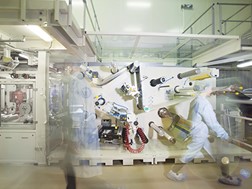Printed electronics processes
Highly homogeneous material conductivity across the entire surface is essential for proper component operation. Material deposition must therefore be perfectly uniform, and ink film thickness, substrate type, resolution, pressure and production speed all need to be parameterized.
Screen printing
This process deposits a film of ink between 20 and 100 µm thick, and achieves good conductivity results on a wide variety of substrates. While it guarantees excellent repeatability, it is a slow process, cost-effective for small quantities with low resolution.
Flexography
Flexography allows a linearity of 60 lines per centimeter, with a fine, hard plate, which is of interest for electronic printing. The thickness of the ink film deposited can reach 6 to 8 µm. The disadvantage of this process lies in the profile of the deposited ink film, which creates a halo at the edges, leading to a thickness irregularity that can disrupt printing.
Flexography is used to produce RFID antennas on labels using silver inks, as well as for printed batteries. The progress made in recent years and the improved conductivity of the inks used make flexography one of the most promising techniques.
Rotogravure
Rotogravure is a printing process using so-called intaglio tooling. This process deposits a relatively thick film of ink, ideal for electronic component applications.
Vacuum evaporation
Vacuum evaporation and spin-coating techniques are regularly employed. However, their low yield (75% of the polymer solution is lost) and high cost make them unsuitable for continuous production.
Slot Die
This deposition process is a non-contact direct transfer process compatible with all inks.
Offset
Offset printing is a well-established process for a multitude of substrates (paper, cardboard, metal, plastics). The resolution is excellent, production speed is attractive and, last but not least, recto/verso printing produces circuits on both sides of a substrate. However, offset also has its drawbacks. To compensate for the lack of conductivity due to the thinness of the ink film (2 to 3 µm), it is generally necessary to apply several layers. In addition, a conductive ink with a viscosity of between 5 and 50 Pa.s is required, which is difficult to achieve with conductive polymers. This is why conductive metallic inks are still mainly used.
Inkjet
Inkjet is the only direct-write digital printing process: only the quantity of ink required is applied directly, under computer control, without the need for tools or contact. It is mainly used with polymer inks, as there is less risk of nozzle clogging, but metallic and ceramic ink formulations based on nanoparticles are also available.
When it comes to printing electronic components, inkjet can pose difficulties, as the positioning of the droplet is not always perfect and can lead to offsets if the process is not mastered. However, the printhead development roadmap suggests that this drawback will be minimized in the medium term. It’s an interesting technique, flexible, multi-material, multi-layer (3D) and easy to implement, even if it’s not as fast as some other unwinding techniques. Its use at the industrial stage for mass markets is more complex to implement, but inkjet printing brings strong technological breakthroughs for high value-added markets (specific components and customs) where it is necessary to manufacture many small series of different components.
Digital printing: aerosol jet printing
Aerosol jet printing enables the selective deposition of materials (conductive, dielectric, biological, etc.) on a micrometric scale on any substrate, whether planar or non-planar, flexible or three-dimensional.
Vacuum deposition
Vacuum evaporation and spin-coating techniques are regularly employed. However, their low yield (75% of the polymer solution is lost) and high cost make them unsuitable for continuous production.

©ARMOR Group

